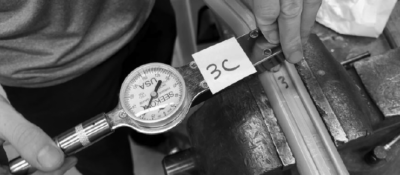Let’s take a trip into the future to see just what we are expecting from our part! it’s so important to visualize how your part will be used in the field under the worse situations possible. Is it intended to fail at a certain cycle, impact, rotation, stress? How does cold or hot environment affect these changes? Some polymers have excellent resilience to temperature fluctuation whereas others fail miserably under certain interactive instances. Let us put on the white gloves to help you understand exactly what your suitable material choice will be and how we can maximize your geometry to absorb both physical and environmental elements and give you a predictable expectation of life for your product!

PHYSICAL MATERIAL PROPERTIES
Property used to define the hardness or softness of a plastic
ASTM D2240 Test Method based on indentation of specimen when force is applied.
Property used to define the how heavy or light a plastic is based on volume
ASTM D792 Test Method based on the ratio of mass of a given volume of material usually reported relative to water
Property used to define the plastics ability to withstand tensile stress while being pulled or stretched without failure
ASTM D638 Method based on pulling a dog bone specimen and reading the rate at which the material yields or breaks
Property used to define the materials ability to resist a force applied in an instantaneous implementation of a load
ASTM D2240 Method based on swing pendulum with a defined weight. Testing can be performed as Notched Izod with and without low temp definitions.
Property used to define the ability to stretch the material of a plastic
ASTM D638 Method based on indentation of specimen when force is applied.
Property used to define the length of recovery of a material after it has been stretched
ASTM D790 Method is based on measuring % of a specimen original length
ASTM D395 Method based on geometric recovery of specimen after force is applied for 24 hours.
Method based on measuring deformation at time intervals from 1 to 1000 hours
Property used to define the amount of growth or shrink a specimen exhibits during temperature change
ASTM D696 Method based on measuring the % coefficient of linear change in length of a material relative to each degree of temperature change
Property used to define a slow deformation phenomena while under constant strain (also known as “Cold Flow”)
ASTM D2990 Method based on measuring deformation at time intervals from 1 to 1000 hours
ISO27 Property used to define a material deflection perpendicular to force applied
Method based on indentation of specimen when force is applied.
ENVIRONMENTAL MATERIAL PROPERTIES
Property used to define the hardness or softness of a plastic
ASTM D2240 Test Method based on indentation of specimen when force is applied.
Property used to define the how heavy or light a plastic is based on volume
ASTM D792 Test Method based on the ratio of mass of a given volume of material usually reported relative to water
Property used to define the plastics ability to withstand tensile stress while being pulled or stretched without failure
ASTM D638 Method based on pulling a dog bone specimen and reading the rate at which the material yields or breaks
Property used to define the plastics ability to withstand tensile stress while being pulled or stretched without failure
ASTM D638 Method based on pulling a dog bone specimen and reading the rate at which the material yields or breaks
Property used to define the plastics ability to withstand tensile stress while being pulled or stretched without failure
ASTM D638 Method based on pulling a dog bone specimen and reading the rate at which the material yields or breaks
